Whether used as a marinade, dipping sauce or even a glaze, this homemade Teriyaki Sauce recipe is full of flavor and perfectly sweet!

I love an amazing sauce with nearly any meal. I drizzle my salmon with pesto, I adore some chicken wings drenched in buffalo sauce. And while I’ll let my littles hoard the ketchup to have on their scrambled eggs, my omelets and breakfast burritos get the sriracha treatment.
But while I like those spicy and savory sauces, I also can’t pass up an Asian-style sauce like teriyaki. Teriyaki on salmon or even pork kabobs is one of my go-to weeknight meals; but you can use it on virtually any vegetable or protein. It’s so easy to make and your dinner will look and taste like you spent all day on it.
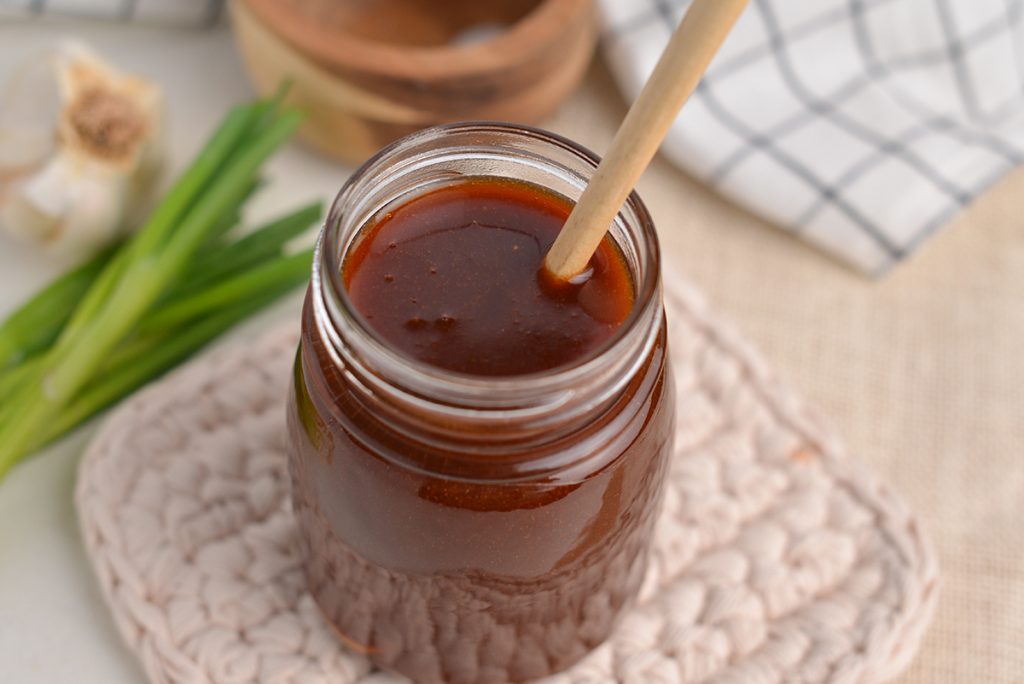
What is Teriyaki Sauce?
The term “teriyaki” initially referred to a cooking method (grilling with a seasoned soy sauce marinade) from as early as the 17th century in Japan. However, while teriyaki sauce is often equated with Japanese cuisine, it was actually created in Hawaii (albeit by Japanese immigrants).
The original soy sauce based delicacy was created in the 1960s and incorporated pineapple juice in addition to many of the other flavors we associate it with today.
Today, teriyaki sauce still remains based in soy sauce with sweeteners and thickeners to create a burst of salty, sweet, umami flavors that delicately coat any food that is graced with it.
Instead of pineapple, mirin, rice vinegar, and brown sugar often serve to sweeten it while cornstarch is popular for thickening the sauce, doing double duty making it either a heartier marinade or delectably dippable.
Is Teriyaki Sauce Gluten-Free?
If you’re worried about the carbs or gluten in the sauce, you can always use an alternative sweetener. Another bonus is that it can be gluten free if you use tamari (without wheat) instead of soy sauce.
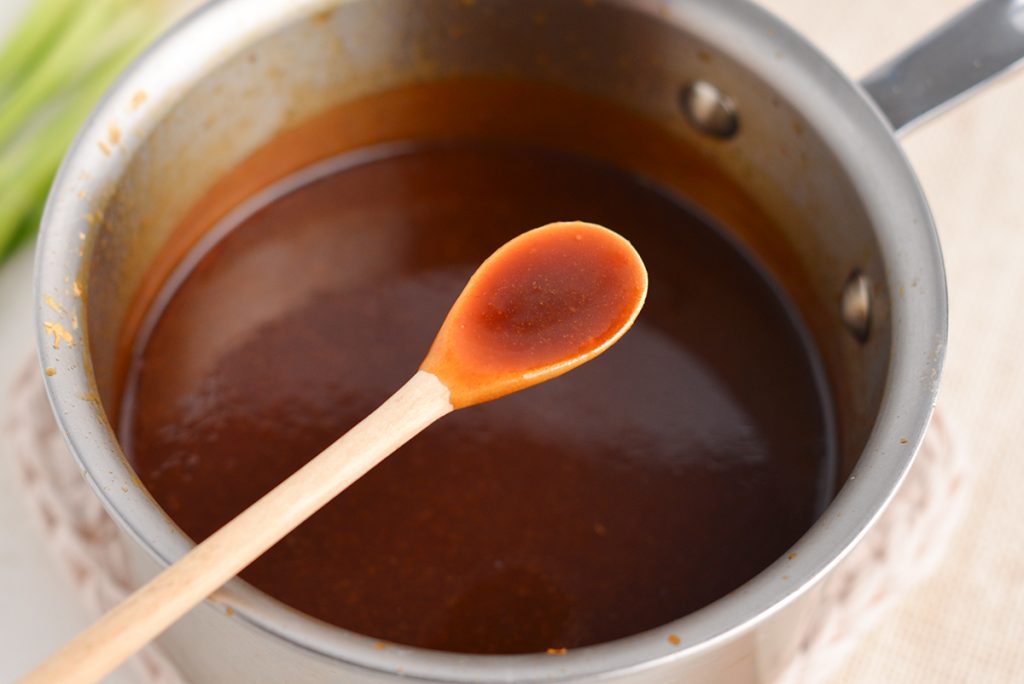
Teriyaki Sauce Ingredients
You can easily find these teriyaki sauce ingredients at the grocery store. Some might be down the international aisle.
- Mirin – with more sugar and less alcohol than sake, this rice wine will add just the level of sweetness you need to the sauce.
- Soy sauce – originating from China, soy sauce imparts umami into this recipe, as well as the saltiness necessary to bring out the other flavors.
- Rice vinegar – made from fermented rice, rice vinegar is sweet. Avoid substituting other vinegars and ensure to use this specifically.
- Sesame oil – made from sesame seeds, this oil is sometimes challenging to source. If you can’t find it at your grocery store, check the “variations” section of this post for some alternative options.
- Light brown sugar – with less molasses than dark brown sugar, light brown sugar is the option to use here. There is plenty of sweetness already derived from the mirin and rice vinegar.
- Garlic cloves – while you can chop or grate, mincing cloves is the best option if you want a smooth sauce.
- Fresh ginger – just like the garlic cloves, ensure that you mince the ginger unless you want a chunkier texture (like for a dipping sauce).
- Cornstarch or arrowroot – cornstarch is the first choice to use for thickening this sauce but arrowroot is a reasonable alternative.
- Water – this helps to achieve the consistency you want to create for this sauce.
How to Make Teriyaki Sauce
I am including instructions for making both a teriyaki marinade and a teriyaki sauce. You need the marinade to make the sauce.
As a Marinade:
- Combine ingredients. Add all of the ingredients to a small saucepan.
- Boil. Bring the mixture to a boil before simmering.
- Blend the mixture until smooth using a small food processor or an immersion blender.
As a Dipping or Drizzling Sauce:
- Make slurry. To make the marinade into a sauce, first make a slurry by whisking together cornstarch and water.
- Add to sauce. Add the slurry to the marinade and whisk until the mixture has a glossy appearance.
- Allow to thicken. Remove from heat and allow the mixture to thicken.
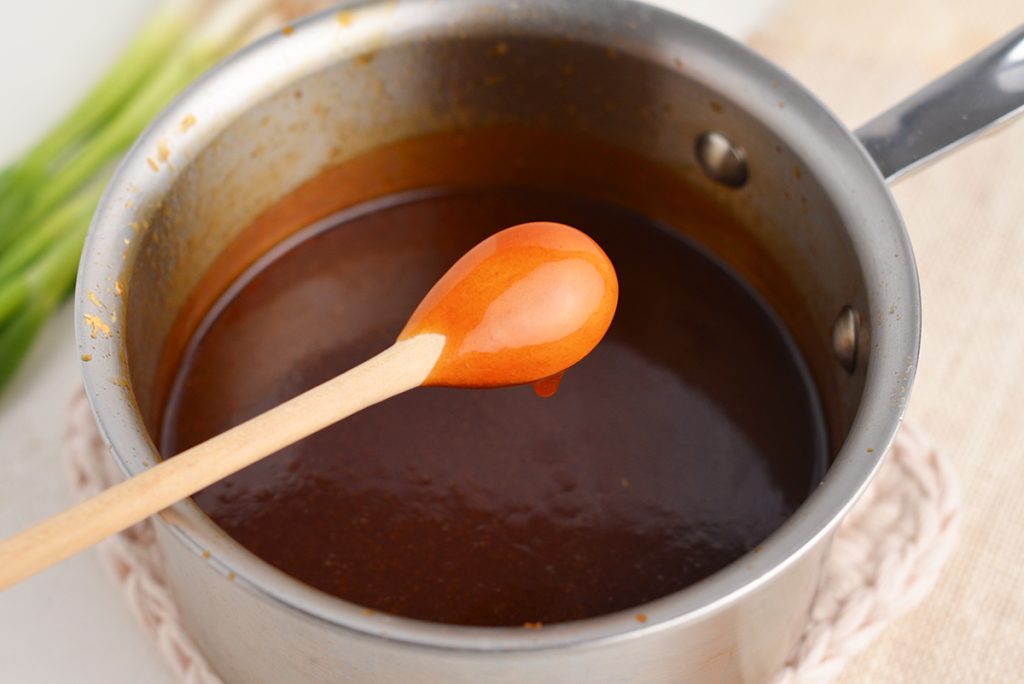
Ways To Use Teriyaki Sauce
This easy teriyaki sauce recipes has tons of uses from marinating meats and fish to dipping appetizers and veggies.
- Salmon, beef, tofu, chicken, pork… you name the protein and teriyaki will take it up a notch. Brush it on the meat, fish, shrimp, or alternative protein, then cook as you typically would. You can even slather it on teriyaki burgers!
- Turn your game day traditions around and use teriyaki instead of buffalo sauce for your wings. Make a creamy peanut sauce to give your wings a Thai flair. Or if you choose to add some heat to your teriyaki sauce, whip up a quick, creamy green curry sauce to offset it. Yum yum sauce is another great dipping option.
- Another great appetizer or snack that dips well in teriyaki is crab rangoon. These tasty cheese-filled wontons are perfect for Saturday night snacking; but they’re also perfect for a party, and they pair amazingly with teriyaki sauce.
- Egg rolls or dumplings are delicious dippers as well.
- You can even elevate standard weeknight dishes with teriyaki sauce. Spread it on a burger, dip your fries in it, even drizzle it on a takeout cheesesteak.
- And don’t sleep on using it outside of the evening hours! Scrambled eggs would love the teriyaki treatment and you could transform your eggs benedict by replacing the hollandaise.

Variations
There are plenty of ways you can make this simple teriyaki sauce your own. Here are a few ideas.
- Starch substitutions – in addition to arrowroot, other substitutions for cornstarch are rice flour, tapioca powder, potato starch, and flaxseed gel. Not all are 1:1 substitutions, so make sure to check before adding them to your sauce.
- Oils – while sesame oil is the best option to use in this teriyaki sauce recipe, you can use other oils. Oil options include olive, walnut, grapeseed, or avocado.
- Heat – want to add some extra heat to your sauce? Toss in some crushed red pepper, fresh hot peppers, sriracha, Thai chili sauce or curry pastes, or even cayenne.
- Sweetness – drizzle some honey into your teriyaki sauce for some added sweet flavor or just add some extra mirin. Pineapple juice or tidbits and even agave also work.
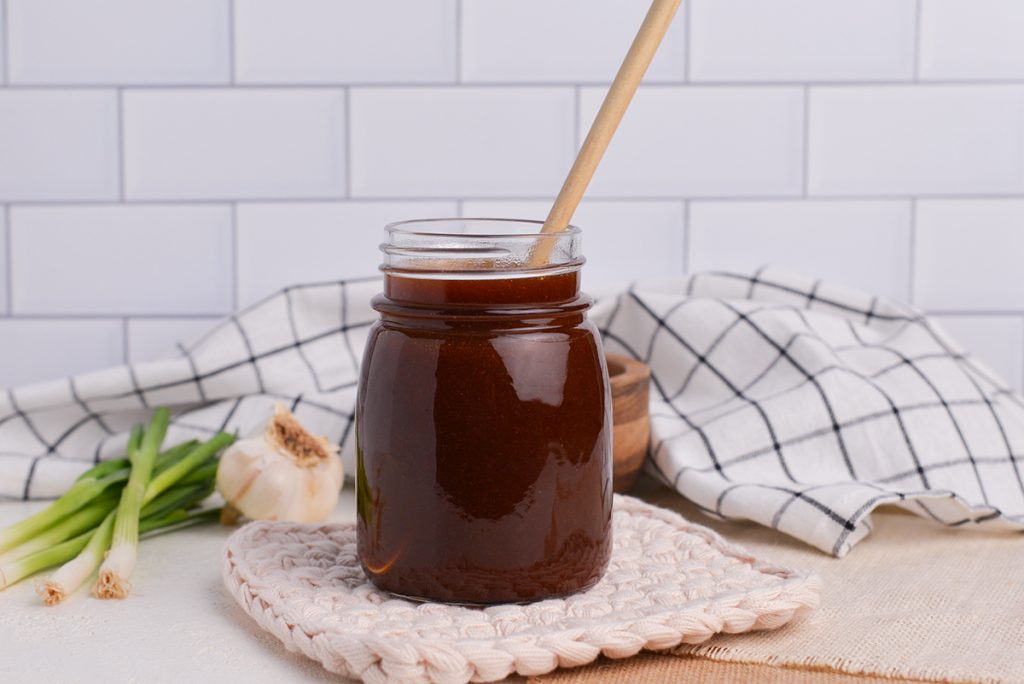
Storage and Freezing
How to Store Teriyaki Sauce
You can store this homemade teriyaki sauce in the refrigerator in an airtight container for up to two weeks.
Can I Freeze Teriyaki Sauce?
Yes, you can freeze this japanese teriyaki sauce. I like to add it to ice cube trays and freeze it that way. But you can also freeze it in a ziplock bag.
Thaw at room temperature or overnight in the fridge. If you need a quick teriyaki sauce, defrost in the microwave or in a saucepan on the stove.
More Easy Sauce Recipes
I love a good homemade sauce to jazz up a meal. Here are a few of our favorites that we know you’ll love too!



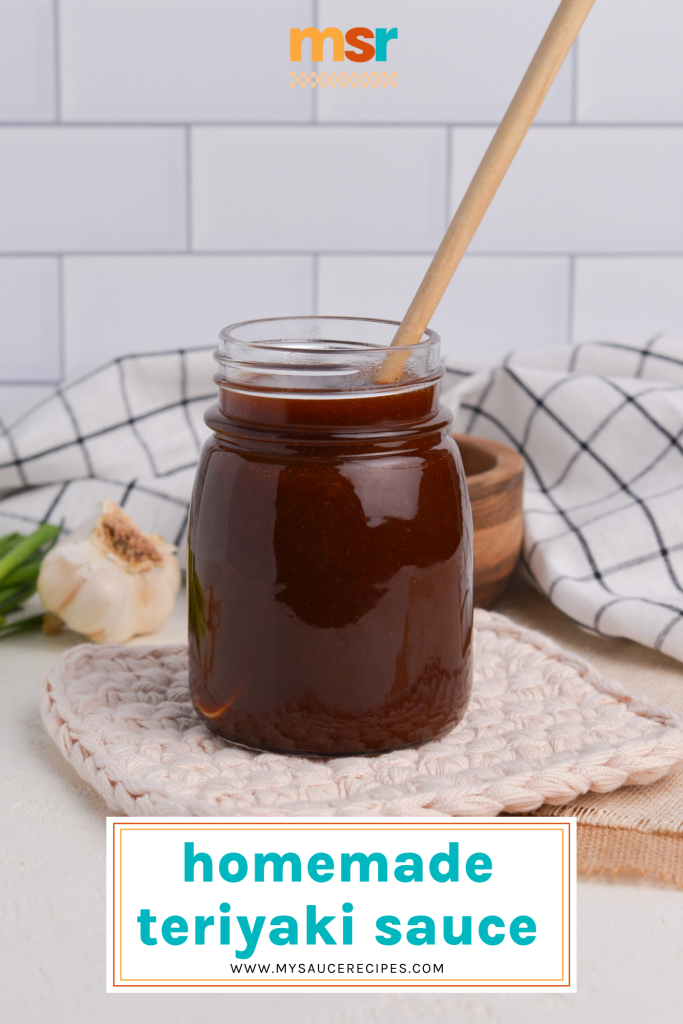
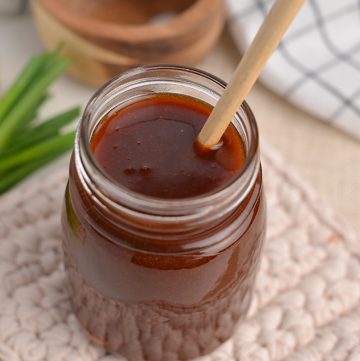
Teriyaki Sauce Recipe
Ingredients
TERIYAKI MARINADE
- 2/3 cup mirin
- 1 cup soy sauce
- 2 tablespoons rice vinegar
- 1 teaspoon sesame oil
- 1/3 cup light brown sugar
- 7 large garlic cloves minced*
- 2 tablespoons fresh ginger minced*
TERIYAKI GLAZE
- 3 tablespoons cornstarch or arrowroot
- 3 tablespoons water
Instructions
- Combine all ingredients for teriyaki marinade in a small sauce pan. Bring to a low boil, then a simmer for 10-15 minutes. Mixture will be thin. Use this for marinating.
- Using an immersion blender or small food processor, blend well.
- To make marinade into a sauce, whisk together cornstarch and water until fully combined. Mix with teriyaki marinade until it becomes glossy. Remove from heat, mixture will thicken as it cools.
- If you’ve tried this recipe, come back and let us know how it was!
Video
Nutrition
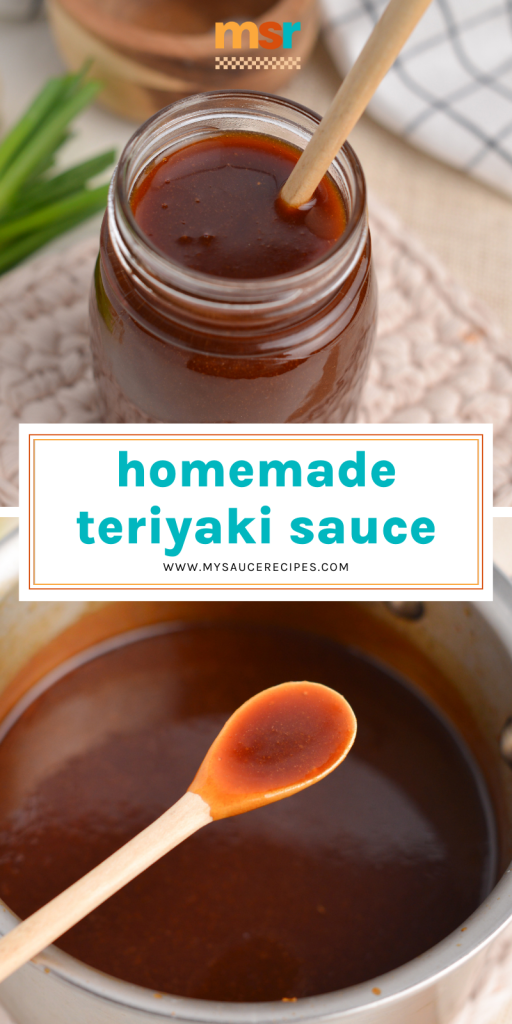

Love how easy it was to make this teriyaki sauce from scratch! I used it on some chicken and my boys loved it! Thank you!
So much tastier than store bought teriyaki sauce. This recipe is a definite keeper.
I made this sauce in bulk and refrigerated. I use it as and when required and its amazingly delicious. Thank you for sharing this recipe.
Such a great recipe! I love the versatility of teriyaki sauce and this came out so delicious!
7000 mg of sodium??! Is that a typo? Did you use Mirin cooking wine with the salt in it or regular mirin wine?
We use an automated service to calculate nutrition. We will double check with them.